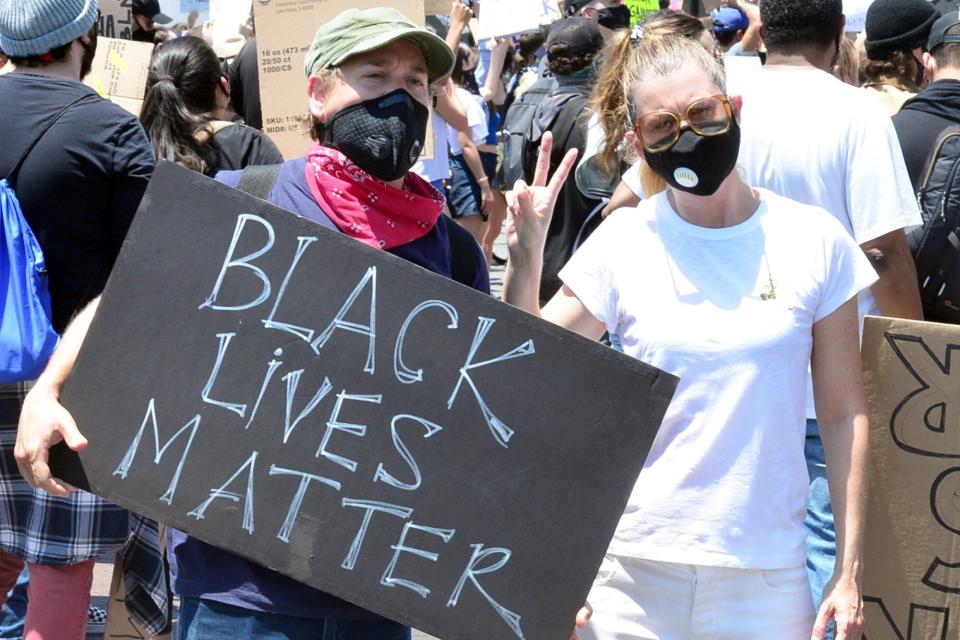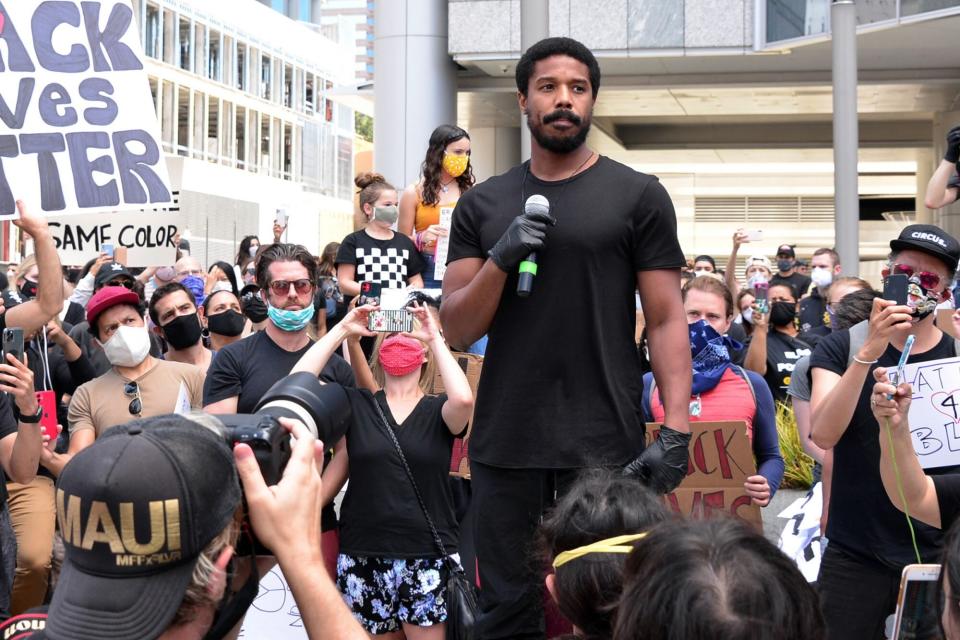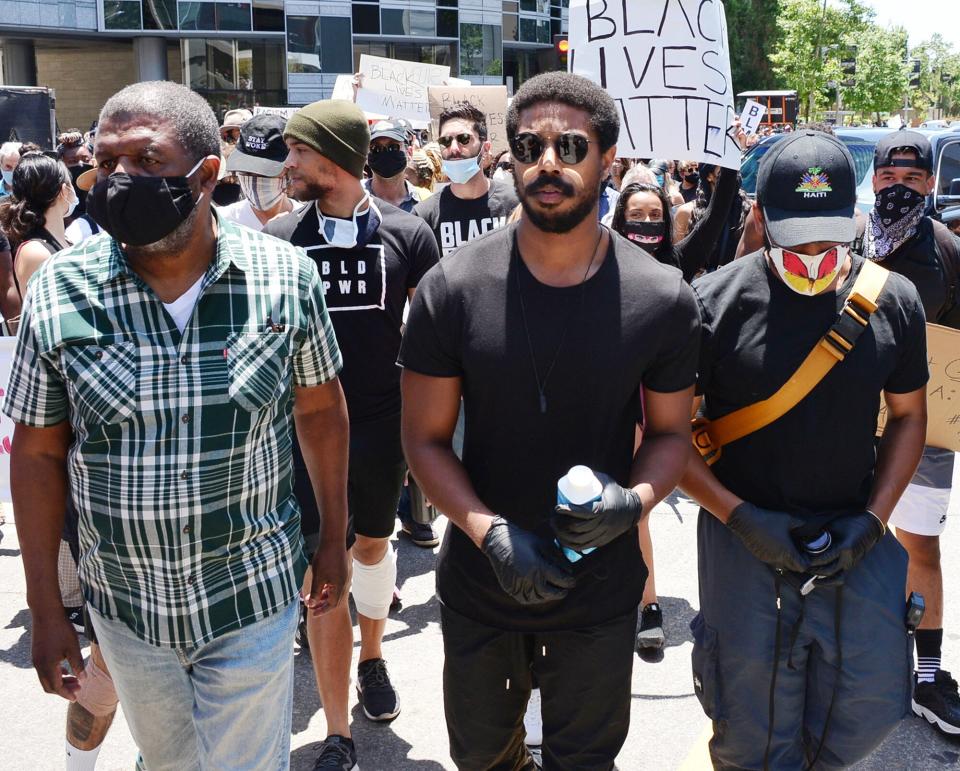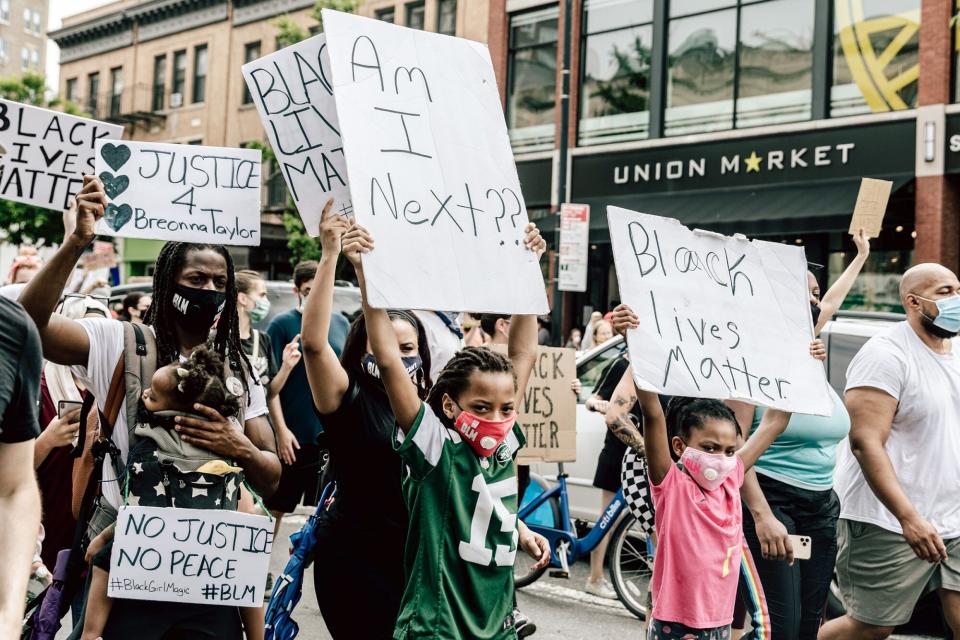What It's Like to Cover Black Lives Matter Protests, Through the Lens of Black Photographers

Steven Eloiseau/Shutterstock
Black Lives Matter protests are entering into their seventh week nationwide, with people marching the streets to protest police brutality, advocating for support of Black trans women and calling for justice for Black people around the world. And as they continue, people are taking in images of the protests and demonstrations on social media and television, experiencing them through the lens of talented photographers on the front lines.
PEOPLE spoke with Steven Eloiseau, 30, and Giles Harrison, 51, two Black photographers who have been working with Shutterstock to document the protests, and they share what it has been like photographing the historical movement and the duality of their jobs as they both take part in the protests and photograph from the outside looking in.
When the protests first started, Steven Eloiseau did not plan on documenting them — he planned to attend as a demonstrator himself. "I felt like it wasn't a good idea to capture the moment and everything that's going on," he tells PEOPLE, "but as it continued I realized it's actually a bad idea if I don't have my camera out. We're living in history, this story needs to be told. Years from now this may still be a fight, and we need documentation of what's occurring in our world now to understand what history brought."
His decision also came as a result of not seeing other Black photographers at the protests with him. "Nothing against that, but with a Black photographer covering the issues, we're able to tell our story better because we know what to capture. It's not just capturing everything we see or what appears to be photo op."

Steven Eloiseau/Shutterstock
That doesn't mean that his role in the protests necessarily changed. "I don't think of myself as a photographer first, I think of myself as a protestor," Eloiseau tells PEOPLE of his experience documenting the marches and protests. Eloiseau says that being Black gives him empathy that helps to capture particularly emotional moments.
"Although this is a job of mine, in this [moment] it's more natural — I can really feel a connection with those who are going through the same thing because I'm going through the same thing. I'm connecting with the protestors," he says.
COVID-19 presents a new challenge: for the most part, photographers are only able to read people through their eyes. But for Eloiseau, it's not as difficult as one would think: "I can still read that emotion. I can see tears, I can see sadness through the eyes. Sometimes before I even know it, I've already put my shutter to capture that emotion because I felt that emotion. It's easier to document what they're feeling because I'm feeling the same thing as well."

Steven Eloiseau/Shutterstock
Veteran photographer Giles Harrison felt the need to be present as a journalist and photographer to capture and document the moment from the start. He tells PEOPLE, "The first day the protest kicked off [in Los Angeles] was a Saturday. I went home early that day and then started to see what was going on TV, and because people were looting and rioting, my wife was like, 'You're not leaving this house. You're not going.' And as a photographer, or even as a journalist, it's killing you, because there's a story happening. You want to be there. You want to be in the midst of it. You want to get involved. And every day after that first day, I've been out there because the awareness needs to happen."
For his part, Harrison tells PEOPLE that he tries to be as objective as possible while shooting.
"It's really a mix of emotions when you're covering things like this because first and foremost, you have a job to do. You're there to document what's going on and you're there to cover it," he explains. But, he admits, "it's hard not to get caught up in the momentum and the spirit of what is going on ... because not only are you observing, you're listening. You're listening to what people are saying. You're watching what people are experiencing and then that can help and has a very profound effect on what you're doing." It also "adds to the sense of responsibility, which is what you overwhelmingly feel to make sure you capture truly, what is going on as best you can," he adds.

London Entertainment/Shutterstock
Eloiseau says that marching and documenting his fellow protestors, while a layered experience, is not as difficult as what comes next: "The hard part for me is looking through the pictures afterward." In the moment, he's caught up in trying to capture people and their emotions, but "looking through the photos becomes that hard part because when I'm editing them or getting ready to publish them, it's like I'm reliving the moment again," he says.
He looks through all of the photos, takes in all of the emotions and memories of the day's events. His solution is to unplug and disconnect when it's possible, but he admits, "I'm not doing it for a long period of time because I've got a job to do."
"It's easier to document what they're feeling because I'm feeling the same thing as well."
—Eloiseau
Eloiseau says that when he's thinking about documenting this time in history, he's reminded of the classes he took in high school or middle school, the photographs he has seen in his textbooks. He admits that back then, he learned the information because he was told he had to, an experience most of us can understand.
But now, things are different: "I have the opportunity to tell my own story. I get to show what's currently happening, what we're fighting for, who is fighting with us and what we have had to do to get through this." He concludes, "I have the opportunity now to actually put my it in my own words, through my visuals, what's happening."

Steven Eloiseau/Shutterstock
As far as using his work to bring about change, Eloiseau says that using his voice as a Black man, and elevating Black voices, is a way to bring about change in and of itself. "It's not a voice that's heard often — Black voices are speaking, but they're not really being listened to. So what I wanted to do with my medium to bring about change is grab attention." And once his photos grab your attention, there's a deeper message: "This is our story and this is our life. Either you are with us or against us."
"The end goal is justice and that's all we want. If I'm documenting it, that's one thing, but the end goal doesn't change."
—Eloiseau
Harrison has a different take on that, saying his work is less about bringing about change and more about bringing awareness to his subject. "One could argue that awareness is a form of change because the more people become aware, the more they're capable of changing things," Harrison explains. "In that aspect, I just want to bring awareness."
Harrison, who mostly shoots celebrities, says that he wants "to show that celebrities are concerned about what's going on more so than whatever they post on Instagram or things like that. That there are celebrities that aren't just donating money, that are getting into the trenches and marching five, six miles in the hot California sun ... I mean, there are some celebrities I know of that have been going with every single march that's out there. And I think that, in the pop culture world, I think people need to see it's more than hawking things on Instagram or Facebook or whatever. I think that's what it requires awareness and conversely, that's what change is."



Both men are, at the end of the day, dedicated to showing the truth to the protests.
Eloiseau doesn't have an agenda when he goes out with his camera, but he asks himself, "If I wasn't here, what would I want to see?" In doing so, he creates a space for people who are unable to protest in person to experience the event through his work. He isn't interested in covering the protests through a specific lens, but rather wants to tell the truth.
And, as Harrison points out, everyone has the chance to tell the truth about this movement. "It's our obligation actually, to shed light on what goes on. That's actually what I would tell people: If you see a protest, if you see anything, if you see cops behaving badly, even if you see cops behaving good, I think it's a duty to document it ... You need to show the good, the bad, and the ugly of life, but you just need to be honest in what you shoot."


Harrison's favorite photo from his time documenting the marches is of Michael B. Jordan leading a Black Lives Matter protest from Century City to Beverly Hills. "The reason I liked it is it was a celebrity leading a march. It's somebody walking at the front of a march, which I like, because it showed him at the forefront. It took my mind back to Martin Luther King marching with Marlon Brando and marching with other celebrities back in the day, and I was just like, 'This helps sum it up. This shows that there is a celebrity willing to be on the front line.' "

Steven Eloiseau/Shutterstock
Eloiseau snapped this photo of two children marching with their parents at a Black Lives Matter protest in New York City, and he tells PEOPLE that it is one of his favorite photos.
"While they were walking, the first thing I noticed was them; they look like they're leading the flock. It looks like they're leading their parents. And they looked directly at me ... I didn't even have my camera up. But the second they made eye contact with me I snapped it right away. I couldn't wait to get home and review the picture because I knew they looked directly at me and I felt that pain right away. You have kids fighting, you have Black kids fighting. There's no age range to who can lose their life to police brutality."
Eloiseau adds that the children were marching on a weekday, noting that they weren't at school (or home doing learning), but instead marching for justice.
"They're young Black kids who, instead of their future worries being about 'What college am I going to go to?' ... Their future looks like, 'I am going to be able to live to see tomorrow?' The fact that they're living in worry or fear of death rather than the fear of not getting into their favorite school, that makes me emotional because that's not the way it should be."
When all is said and done, Eloiseau says that his job is a means to an end.
"There's only so many things I can do with my voice alone because I'm just one person, but I can use my photography as a platform to actually tell the story, to use it as a platform for my social justice," Eloiseau tells PEOPLE. He explains that he still doesn't look at his decision to take photos of the protests as a job, but as part of the movement.
"The end goal is justice and that's all we want," he says. "If I'm documenting it, that's one thing, but the end goal doesn't change."

